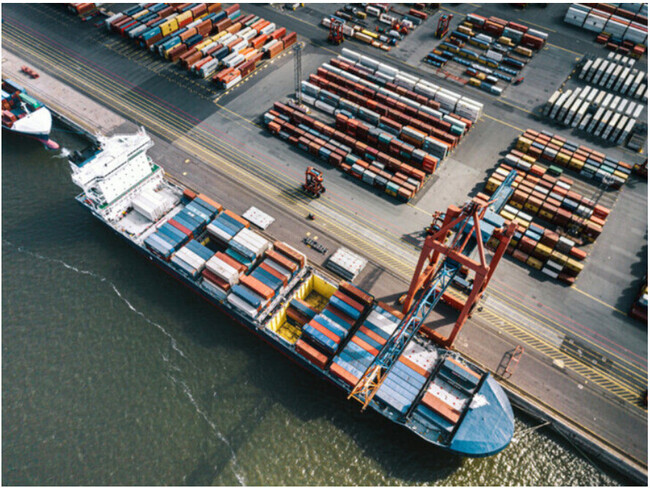hankyoreh
Links to other country sites 다른 나라 사이트 링크
2022 saw biggest dip in Korea’s GDP since 2008 financial crisis

Last year, South Korea’s gross domestic product shrank by the largest amount since the 2007-2008 global financial crisis, dropping two places to rank 13th in the world.
This reflects the structural weaknesses of the Korean economy, which relies heavily on certain industrial sectors such as raw material imports, semiconductor exports, and exports to China.
According to Hankyoreh’s analysis of the World Bank’s GDP data for the world’s top 100 economies, South Korea’s nominal GDP for 2022 was US$1.665 trillion, down 8% from 2021, showcasing the largest decline since 2009 (-9.9%), during the financial crisis.
Denominated in the US dollar, South Korea’s GDP jumped 10.1% in 2021 after falling 4.3% and 0.4% before and after the COVID-19 pandemic in 2019 and 2020, respectively. Then, in 2022, it began to decline again.
Among the top 100 largest economies, only six countries saw a larger decline in GDP than South Korea in 2022: Ukraine (-19.7%), Sri Lanka (-15.9%), Japan (-15.5%), Myanmar (-8.8%), Ghana (-8%) and Sweden (-8%).
Ukraine and Sri Lanka are experiencing war and currency crises, while Japan has seen its yen-to-dollar exchange rate surge 19.8% in the past year in the wake of monetary easing.
Excluding these countries, South Korea’s decline in GDP is more pronounced than other major economies.
South Korea also dropped two spots in terms of economic scale, from 11th place in 2021 to 13th in 2022. Having entered the top 10 in 2020, Korea now finds itself back to where it was nine years ago, in 2013.
The significant backstepping of the dollar-denominated GDP is due to the Korean won’s pronounced weakness amid a strong dollar following US interest rate hikes last year, which resulted in a trade deficit.
According to the Bank of Korea, the value of the won against the dollar in 2022 (annualized average) plunged 12.9% from 2021 — meaning a surge in the won-dollar exchange rate. The depreciation is larger than that of the euro (11%), British pound (10.1%), Canadian dollar (3.9%), and Swiss franc (4.5%).
This is largely due to a decline in the semiconductor industry, sluggish exports to China, and a surge in energy imports.
The exchange rate is not the only factor to blame. Germany, the UK, France, Italy and Spain also experienced a similar level of currency weakness as South Korea in 2022, but the decline was smaller than in South Korea. For example, Germany’s year-over-year decline in GDP in 2022 was -4.4%, the UK -1.7%, France -5.9%, Italy -4.9%, and Spain -2.1%.
The future seems even more bleak. In 2009, South Korea’s GDP plummeted 9.9% year-over-year, but rebounded strongly in 2010 and 2011, growing 21.2% and 9.5% respectively.
This year, however, it is difficult to expect a steep recovery based on the semiconductor industry’s comeback. Some analysts believe that the Korean economy is vulnerable to new trends in the global trading order, including supply chain interruptions and reorganization, and the rise of economic security.
According to World Bank statistics, South Korea’s nominal GDP per capita in 2022 was US$32,255, down 7.8% from 2021. However, among the top 50 largest economies, South Korea’s per capita GDP ranking remained at 22nd in both 2021 and 2022. Notably, the income gap with Japan narrowed to US$1,560 in 2022 due to a 15.1% plunge in the per capita GDP for Japan (US$33,815) tied to a weak yen.
By Park Jong-o, staff reporter
Please direct questions or comments to [english@hani.co.kr]

Editorial・opinion
![[Editorial] Intensifying US-China rivalry means Seoul must address uncertainty with Beijing sooner than later [Editorial] Intensifying US-China rivalry means Seoul must address uncertainty with Beijing sooner than later](https://flexible.img.hani.co.kr/flexible/normal/500/300/imgdb/original/2024/0517/8117159322045222.jpg) [Editorial] Intensifying US-China rivalry means Seoul must address uncertainty with Beijing sooner than later
[Editorial] Intensifying US-China rivalry means Seoul must address uncertainty with Beijing sooner than later![[Column] When ‘fairness’ means hate and violence [Column] When ‘fairness’ means hate and violence](https://flexible.img.hani.co.kr/flexible/normal/500/300/imgdb/original/2024/0516/7417158465908824.jpg) [Column] When ‘fairness’ means hate and violence
[Column] When ‘fairness’ means hate and violence- [Editorial] Yoon must stop abusing authority to shield himself from investigation
- [Column] US troop withdrawal from Korea could be the Acheson Line all over
- [Column] How to win back readers who’ve turned to YouTube for news
- [Column] Welcome to the president’s pity party
- [Editorial] Korea must respond firmly to Japan’s attempt to usurp Line
- [Editorial] Transfers of prosecutors investigating Korea’s first lady send chilling message
- [Column] Will Seoul’s ties with Moscow really recover on their own?
- [Column] Samsung’s ‘lost decade’ and Lee Jae-yong’s mismatched chopsticks
Most viewed articles
- 1For new generation of Chinese artists, discontent is disobedience
- 2[Editorial] Transfers of prosecutors investigating Korea’s first lady send chilling message
- 3[Exclusive] Unearthed memo suggests Gwangju Uprising missing may have been cremated
- 4[Editorial] Intensifying US-China rivalry means Seoul must address uncertainty with Beijing sooner t
- 5S. Korea “monitoring developments” after report of secret Chinese police station in Seoul
- 6N. Korean media upgrades epithet for leader’s daughter from “beloved” to “respected”
- 7Yoon says concern about biased diplomacy is being incited by “communist totalitarian forces”
- 8[Column] US troop withdrawal from Korea could be the Acheson Line all over
- 9Xi, Putin ‘oppose acts of military intimidation’ against N. Korea by US in joint statement
- 1060% of young Koreans see no need to have kids after marriage